Flexible Fluorine (ETFE) Resin Tubing [Model Number: E-SJ]
Multi-Purpose / Chemical Resistance Tube | Single-layer teflon tubing is hard (stiff) and easy to break. Our Flexible Fluorine (ETFE) Resin Tubing is an alternative tubing for a teflon tubing.
Fluids
 chemicals
chemicals ink
ink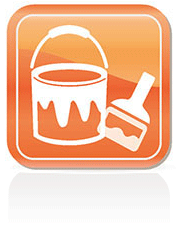 paint
paint flux
flux food
food drink
drink alcohol
alcohol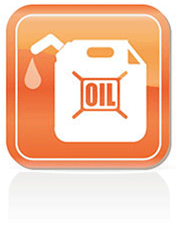 oil
oil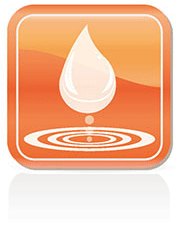 water
water powder
powder Applications
- For Industrial Ink-Jet Printers (For Ink-Supplying Pipes)
- For Transferring Solvent-Based Inks
- For Transferring Paints, Solvents and Adhesives
- For Transferring Chemicals used in Laboratory Equipment
- For Transferring Chemicals used in Semiconductor-Related Devices (Photoresist Processes) and Flat Panel Display (FPD) Manufacturing Devices
- For Transferring Beverage and Food
- For Transferring Fatty Acid Ester such as Biofuel (BDF)
- For Transferring Chemical and Industrial Wastes
- For Transferring Alcohol, Cosmetics and Chemicals
- For Transferring Chemicals used in Medical Equipment, Endoscope and so on
- For Transferring Chemicals used in Manufacturing Fuel Cell and Pure Water
- For Printing Head, Wide-Format Ink-Jet Printers, Textile Printers, Ceramic Tile Printers, 3D Printers
- For Filling Line of Paints and Adhesives
- For Filling Line of Fragrance, Colorant and Additive
- For Air Supplying Pipes at Clean Room
Functions
Solvent Resistance
Non-PVC
Non-Adhesiveness
Chemical Resistance
Low Elution
Low Odor
Food-Sanitation
Flexibility
Transparency
Oil-Proof
Cold Resistance
Alcohol Resistance
Characteristics
- Chemical Resistance...Since the inner layer is made of ETFE fluorine resin, E-SJ is resistant to most of the chemical substances. For more information, please refer to chemical resistance data.
- Flexibility...Due to the laminated structure, compared with a single-layer fluorine tubing, E-SJ is superior in flexibility. This improves your work efficiency. Please check the video clip to see the difference in flexibility between E-SJ and a teflon tubing.
- Hard to Break...Unlike a single-layer fluorine tubing, E-SJ is less likely to break. (Even if it breaks, you can restore its shape to some extent.)
- Higher Non-Adhesiveness...Since ETFE fluorine resin is superior in terms of water-proof, you can wash out the fluids very easily.
- Abrasion Resistance...Fluorine resin (inner layer) shows high levels of abrasion resistance. Thus, you can even transfer chemical slurry.
- Plasticizer-Free...E-SJ does not contain plasticizer (an elution material) at all. E-SJ is an oil-free tubing.
- Non-PVC...E-SJ is made of non-PVC materials.
- Low Elution and Low Odor...Since E-SJ contains very low levels of elution and odor, it is highly recommended for use in transfers of food, beverage and cosmetics.
- High Purity...Fluorine resin does not contain any additives such as plasticizer, so E-SJ is suitable for transferring high purity chemical fluids.
- Easy to Cut...Since we print the cut mark on the hose every meter, it is easy to cut the length you would like to.
- Transparency...E-SJ enables you to check the fluid very easily.
- Original Fittings...By using our original fittings, you can avoid accidents which are caused by incorrect choices of hose and fittings. For more information on our original fittings, please scroll down to the end.
Certificates and Regulations
- RoHS Compliant...E-SJ is compliant with RoHS requirements (Directive: (EU) 2015/863). (RoHS Compliant means that E-SJ does not contain RoHS 10 restricted substances or it does not exceed the upper threshold of RoHS 10 restricted substances.) Certificate is available on request.
- EU REACH and UK REACH...E-SJ is compliant with REACH SVHC 31st list (242 substances). Certificate is available on request.
- Non-Use of UV-328...E-SJ does not contain UV-328. Certificate is available on request.
- TSCA (Toxic Substance Control Act) Compliance...E-SJ does not use decaBDE, PIP(3:1), 2,4,6-TTBT, PCTP and HCBD. Certificate is available on request.
- PFOA and PFOS...E-SJ does not contain perfluorocarboxylic acids (PFCAs C 9 - C 14), their salts or PFCA-related substances. Certificate is available on request.
- UL94HB Equivalent...According to the third-party institution test, E-SJ is confirmed as equivalent to UL94HB (Flame Retardancy Test UL94HB Horizontal Combustion Test). Certificate is available on this webpage.
- Food Sanitation Act Compliant...E-SJ conforms to the Food Sanitation Act No.380 (No.380 of the Ministry of Health and Welfare for Food Sanitation) (Conformity to N-Heptane) and the Food Sanitation Act No.324 (Positive List System) [No.324 of the Ministry of Health, Labour, and Welfare]. Regarding the conformity of the Food Sanitation Act No.324 (Positive List System), please download the certificate.
- Regulation (EC) No 1935/2004 and (EU) No 10/2011...An inner layer of E-SJ is compliant with (EC) No 1935/2004 and (EU) No 10/2011.
- Compliance with ADI/TSE/BSE Free...An inner layer of E-SJ does not contain ADI, TSE, and BSE.
- Compliance with BPA Free...E-SJ does not contain BPA (Bisphenol A) (CAS No.80-0-7).
Packing Images
Product Standard
Standard Size (mm size)
Standard Size (inch size)
Made-to-Order Size Example
- Temperature Range : -20 - 80 $^\circ$C (-4$^\circ$F - 176$^\circ$F)
- Color : Clear
*Please note that the value of "Minimum Bend Radius" is NOT equal to that of "Flexibility." About "Flexibility," please refer to the value of "Amount of Deflection" in the section of Technical Information or request the sample.
*If you are interested in Made-to-Order size and other E-SJ offers (such as E-SJ Cleanroom Packing Type), please fill out the following form. (We can also produce a special size that is not listed on the table above. Please note that MOQ applies for made-to-order size.)
Made-to-Order Inquiry Form
Leaflet Request
For more information on our Product Standard of E-SJ, please click "Product Leaflet Download" above.
Specification Request
For more technical information (such as Thickness of Each Layer and Precautions in Use) on E-SJ, please click "Product Specification Download" above.
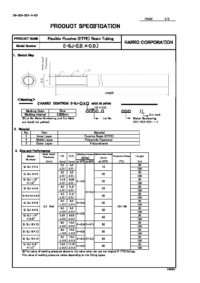
Cautions:
- We do not have our original fittings for E-SJ-4.3$\times$6.4, E-SJ-8$\times$10, E-SJ-9$\times$12, and all inch sizes.
- In case you have to use your fittings other than our original fittings, please do not use the joints to seal an outer surface of the tubing. This may result in the bursting or coming off from the tubing.
- When you use our products, please refer to "Precautions for Use." ("The Precautions for Use" of E-SJ is also downloadable here.)
- In terms of chemical resistance, please refer to "Chemical Resistance Data."
- Although the inner layer is made of ETFE fluorine, please make sure whether or not E-SJ is usable for high purity fluids before you use.
- Although the inner layer is resistant to fluids, depending on working environments, the fluids would be permeated through the inner layer, resulting in the danger of swelling and degradation of the middle or outer layer.
Case Study
Problem: A Single-Layer Teflon Tube is hard and easy to break.
A gas analysis equipment manufacturer (called "Company A" hereinafter) was looking for a flexible tubing for better handling and easy installation. An inner layer should be made of fluorine, and its bending radius is smaller and hard to break.
HAKKO Solution:
HAKKO proposed E-SJ: Flexible Fluorine (ETFE) Resin Tubing and provided a sample. E-SJ is made of three layers: the inner layer is made of ETFE fluorine, the middle layer is made of polyamide and the outer layer is made of polyurethane. The inner layer shows a feature of smoothness and higher levels of chemical resistance. Also, the outer layer is made of polyurethane, which makes the tubing softer and more flexible. As a result, compared with a teflon tubing, E-SJ is flexible, hard to break and restore its shape even if it kinks. After Company A evaluates our E-SJ, E-SJ passed the criteria of smoothness, chemical resistance and flexibility.
Frequently Asked Questions
Question: E-SJ is harder than I expected. I need a softer product.
Answer: If you have already known a teflon tube, you must have realized that E-SJ is much softer than a teflon tube. Due to a multi-layer structure, E-SJ is much more flexible than a teflon tube. However, for I.D. 6mm and 8mm, we have a softer version than E-SJ. The product name is "Flexible Fluorine (ETFE) Resin Tubing (PVC Type)" and its model number is E-SJV. If you are interested in E-SJV, please visit its product website. Also, if you need a small size, softer tubing than E-SJ, we also have E-SJUS: Flexible Fluorine (ETFE) Resin Tubing (Ultra Soft Type).
Question: What is the difference between E-SJ and E-SJ-CBU?
Answer: The only difference is the outer color of polyurethane. E-SJ-CBU is recently developed responding to customers' needs. By using both E-SJ and E-SJ-CBU, customers can differentiate the manufacturing lines.
Question: E-SJ is a multi-layer tubing. Is it easier to peel off the layer?
Answer: No. Even though E-SJ consists of multi-layers, the inner layer and the outer layer are strongly adhered each other. Thus, you do not have to worry about de-lamination.
Technical Information
(A) Relationship Graph between Working Temperature and Maximum Working Pressure
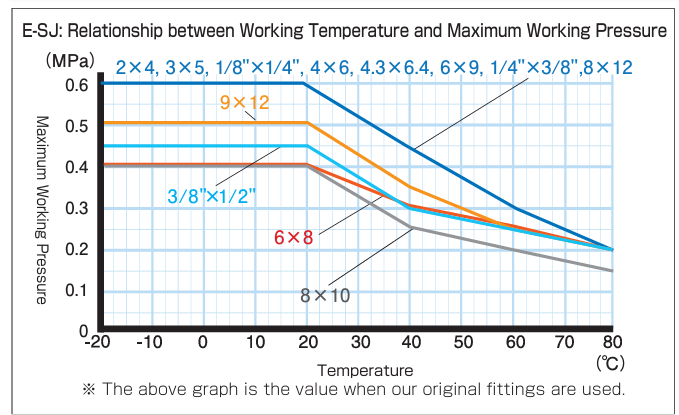
(B) Flexibility Comparative Data
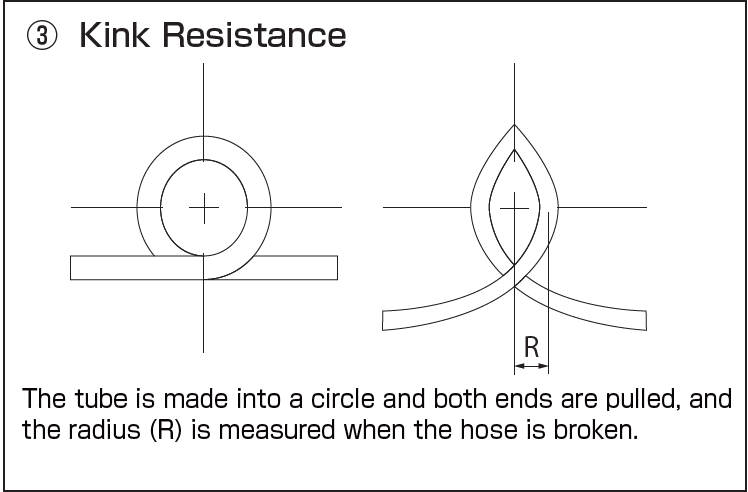
Results: "Amount of Deflection" is one indication of flexibility. Flexibility varies depending on hose (tubing). The larger the amount of deflection is, the more flexible the hose (tubing) is. Thus, E-SJ is much more flexible than PTFE and PFA tubing.
(C) Flexibility Difference Image (PTFE Tubing vs. E-SJ)

(D) Non-Adhesiveness Comparison Data
Critical Surface Tension: The surface tension of the assumed fluid which has the contact angle of zero against solid.
Results: Since the lower value of "Critical Surface Tension" and higher value of "Contact Angle for Water" show higher non-adhesivenss, ETFE fluorine material shows the highest non-adhesiveness.
(E) Washability Data
Results: In comparison with a Nylon hose, Flexible Fluorine (ETFE) Resin Hose is excellent in non-adhesiveness of the inner layer, so you can reduce washing time and save cleaning solutions and labor costs.
(F) Transparency Comparison Image: E-SJ vs. PTFE Tubing
![[Sample] We pour the same yellow paint through both tubings and seal both ends. [Result] As you can see, compared with a PTFE tubing, HAKKO E-SJ is easier to see through.](https://hakko-eightron.com/wp-content/uploads/2017/11/Easier-to-see-through.png)
[Sample]
We pour the same yellow paint through both tubings and then seal both ends.
[Result]
As you can see, compared with a PTFE tubing, HAKKO E-SJ is easier to see through.
(G) Leach Test Data
*Test Method: JIS S 3200-7: 2004 [Equipment for Water Supply Service]
HAKKO Original Fittings for E-SJ
| Product Name | Materials, Characteristics |
| Fittings for Multi-Layer Tubing [Model Number: E-FTS-F]] |
- Material: SUS316L (SS316L) (Body) and SUS304 (SS304) (Nut)
- It is designed by HAKKO tubing products, so you do not have to worry about fluid leakages and coming off.
- Specify temperature range and working pressure for each product.
- It is excellent in corrosion resistance [Body: SUS316L (SS316L)].
- Since it is made of stainless steel (Passivation Treatment), you can transfer a wide variety of fluids.
|

|
| PEEK (Carbon Reinforced) Nut Type Fittings [Model Number: AL]] |
- Material: PEEK
- Lightweight...Fitting weight is less than one-fifth, compared to same-size SUS joints, leading to overall weight reduction of equipment.
- Great Heat Resistance...PEEK material has excellent heat resistance among resins.
- Chemical Resistance...PEEK material has excellent resistance to a wide range of chemicals including acids, alkalis and organic solvents.
- Mechanical Strength...Carbon fiber is added to the engineering plastic of PEEK, which is strong in tensile and impact resistance.
|
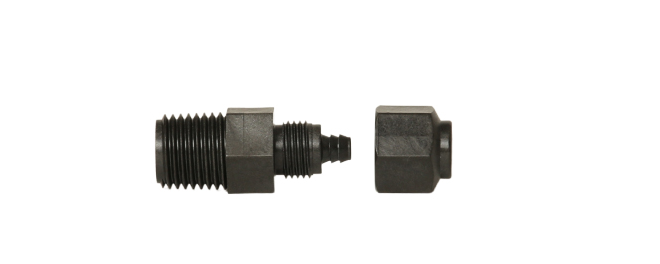
|
| Fittings for Multi-Layer Tubing (with Tubing Guide) [Model Number: E-FTS-GN]] |
- Material: SUS316L (SS316L) (Body) and SUS304 (SS304) (Nut)
- It is designed by HAKKO tubing products, so you do not have to worry about fluid leakages and coming off.
- Specify temperature range and working pressure for each product.
- It is excellent in corrosion resistance [Body: SUS316L (SS316L)].
- Since it is made of stainless steel (Passivation Treatment), you can transfer a wide variety of fluids.
|
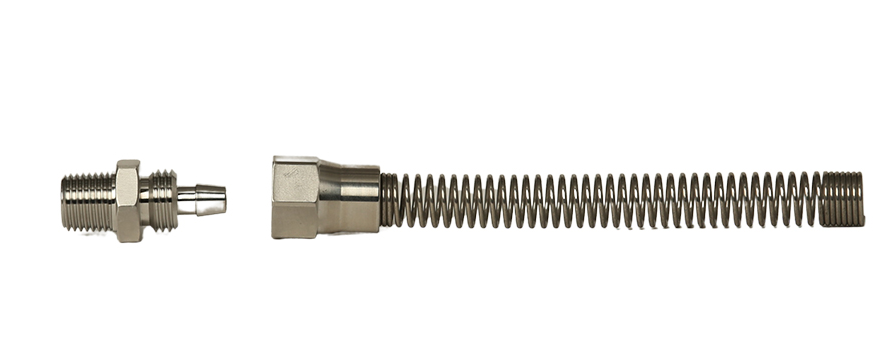
|

20220810.jpg)




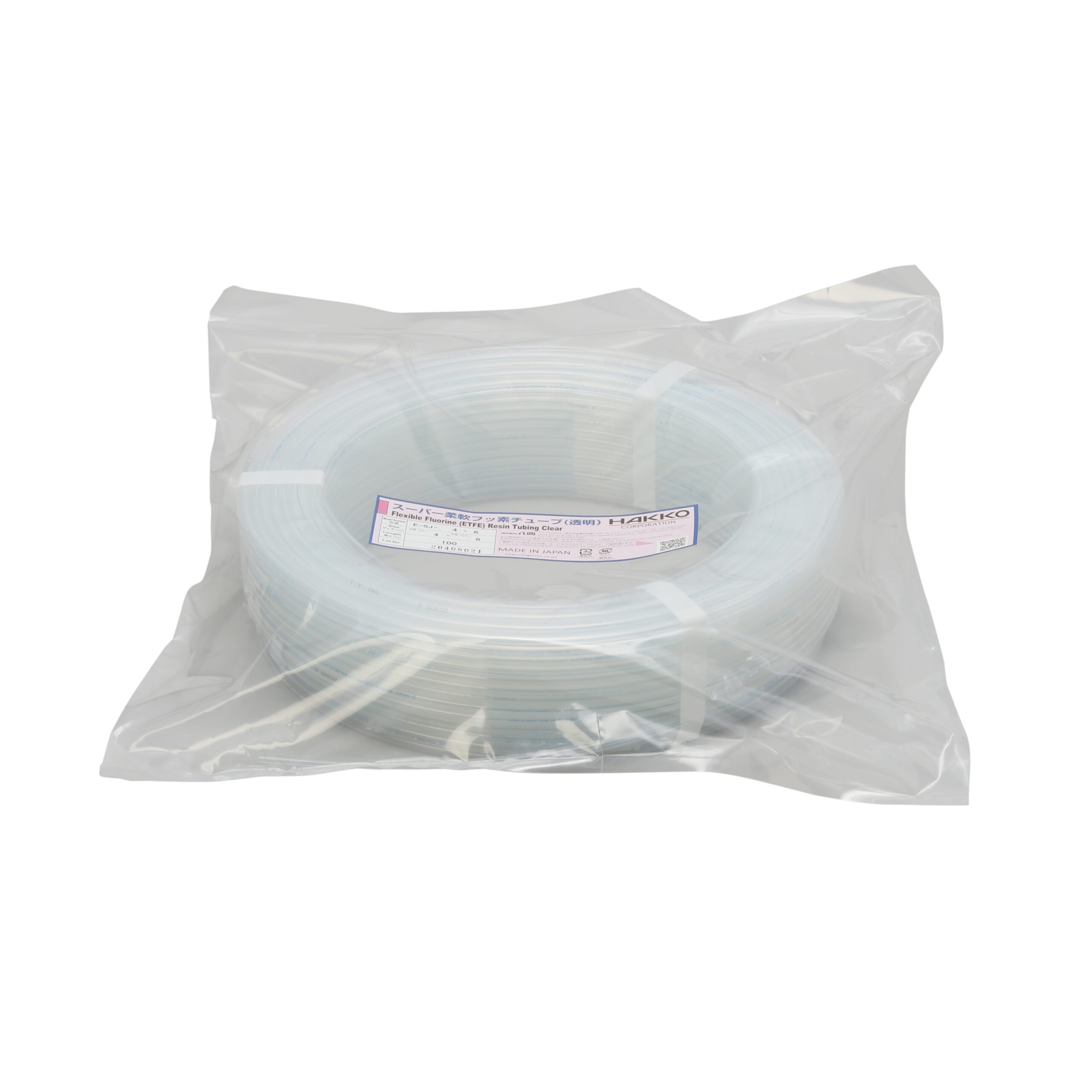
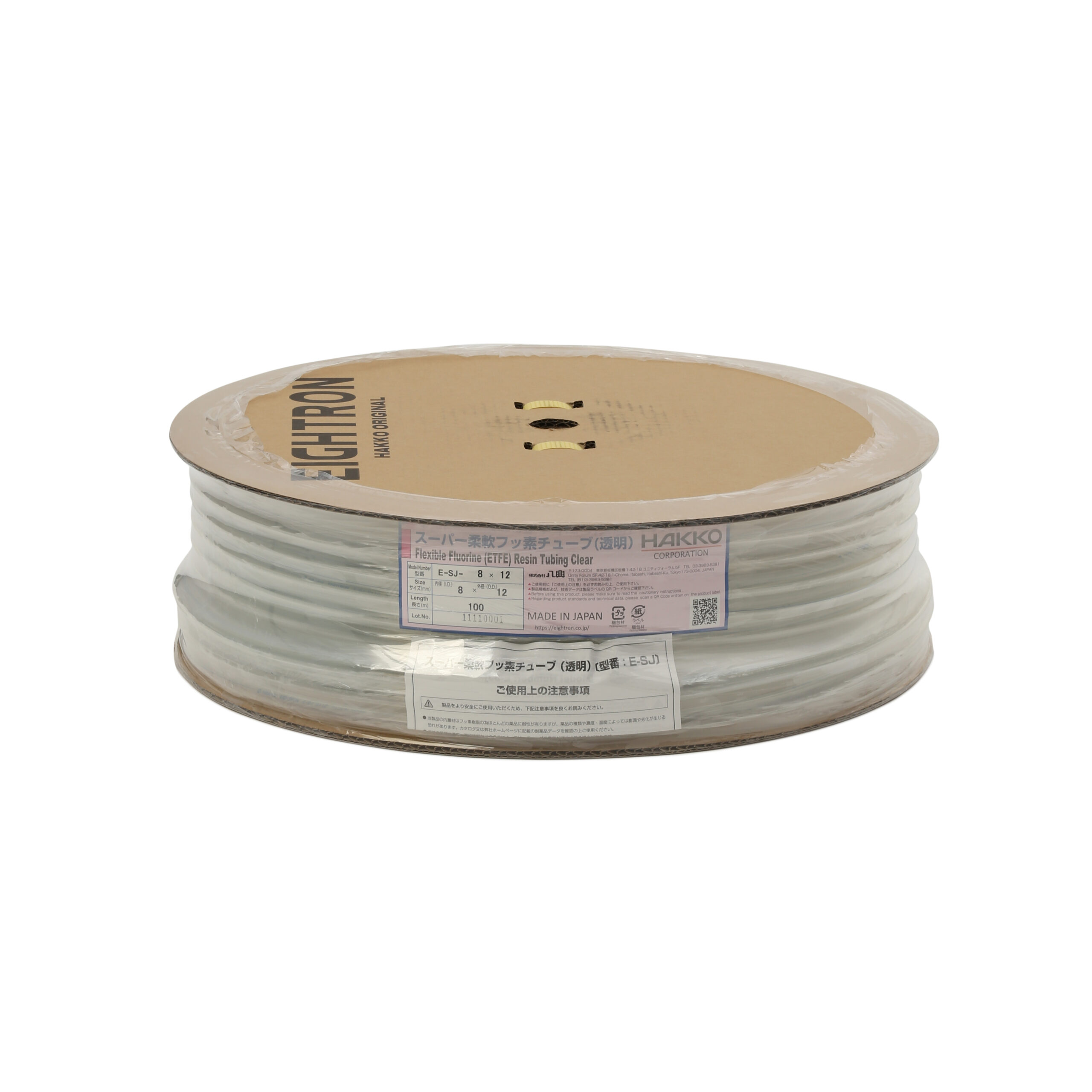
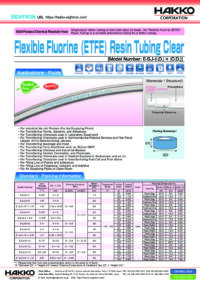


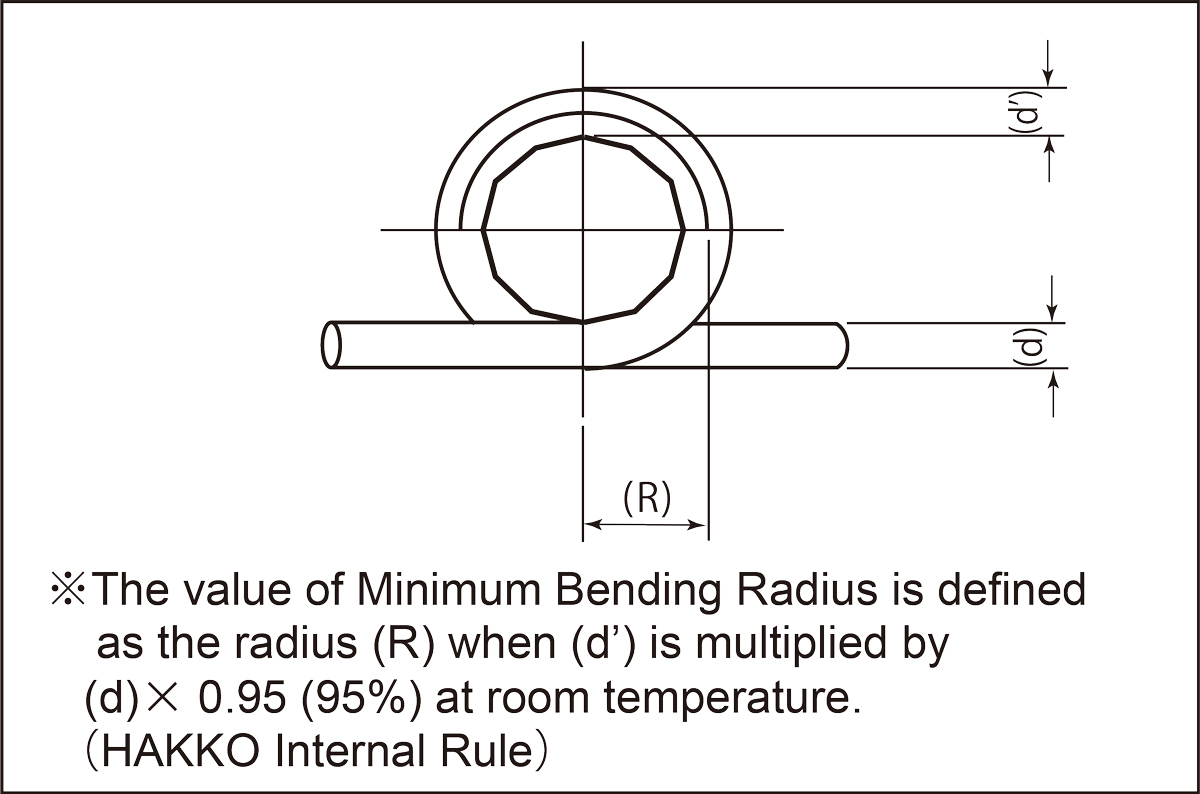
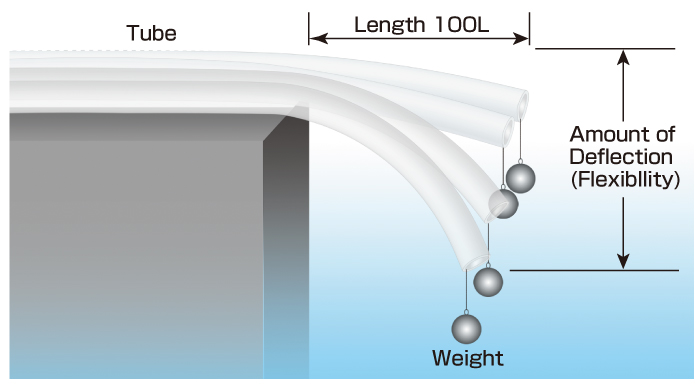




![[Sample] We pour the same yellow paint through both tubings and seal both ends. [Result] As you can see, compared with a PTFE tubing, HAKKO E-SJ is easier to see through.](https://hakko-eightron.com/wp-content/uploads/2017/11/Easier-to-see-through.png)













